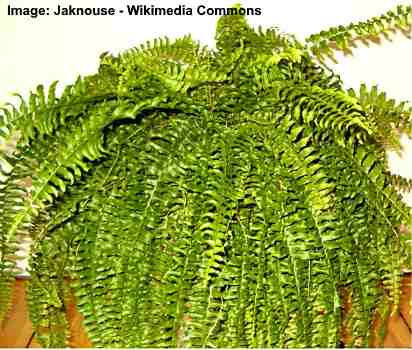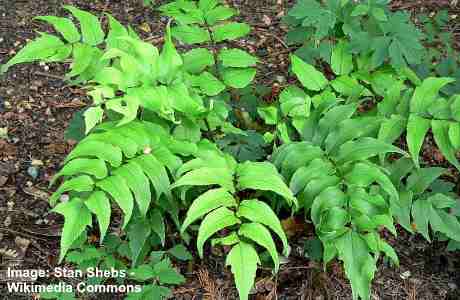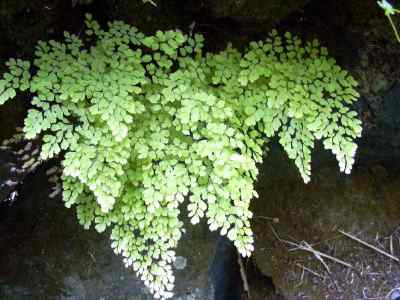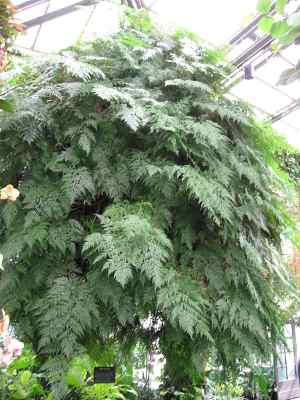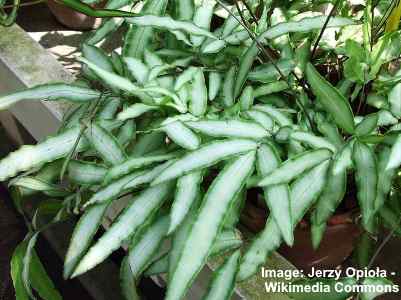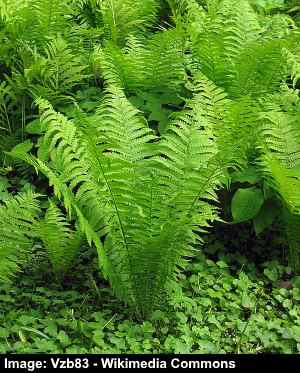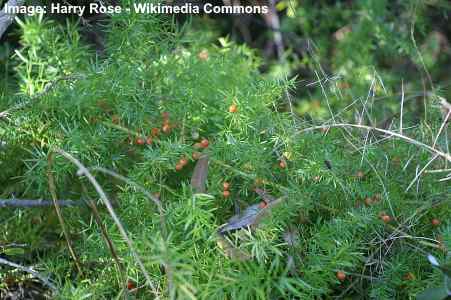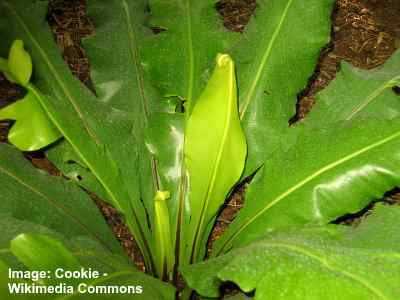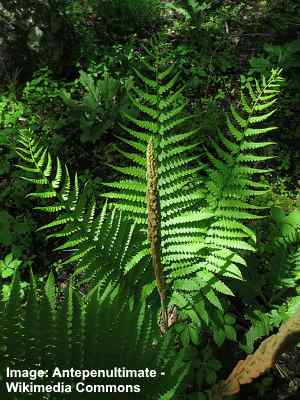Types of Ferns: Varieties of Indoors and Outdoors Fern Plants (Including Name and Picture)
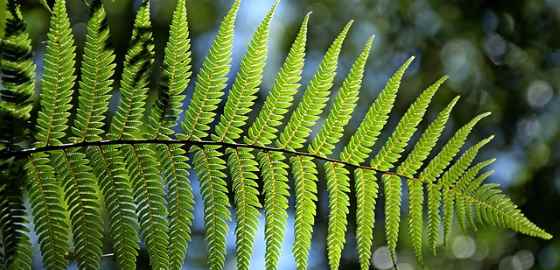
There are many types of ferns that you can grow indoors as houseplants or outdoors in your garden. Many indoor fern varieties are easy to grow and care for. Ferns are a great type of leafy plant and their green leaves can add beauty to any room as well as help to clean the air. Ferns planted outdoors are great for ground cover in the right conditions.
Fern plants are a type of vascular plant that belongs to the Polypodiopsida class of plants. They are also some of the oldest plants that grow on the planet. According to some estimates, there are over 10,000 species of ferns.
Unlike many other types of plants, ferns don’t produce flowers. Most fern species have leaves (called fronds) that are composed of blade-like leaves (pinnae) attached to a stem. Most indoor fern plants grow to about 1 or 2 ft. (30 – 90 cm) tall. In the wild, the tallest ferns can grow to around 82 ft. (25 m) tall!
In this article, you will find out how to identify the different species of ferns and how to take care of them. You will also learn about the best ferns to grow indoors and which ones thrive outside.
Indoor Ferns And How to Care For Them
In general, indoor ferns are hardy, low-maintenance houseplants. However, there are a few things to know about caring for these green leafy plants.
Ferns originated in dense tropical shady woodlands and it’s important that house ferns have a similar environment. This means that fern houseplants grow best indoors where they get plenty of shade. You should keep them away from windows where there is direct sunlight.
When caring for indoor ferns, you should keep rooms at an even temperature of around 70°F (21°C). You will also need to ensure that there is plenty of humidity and you may need to mist your fern daily to help it grow well indoors.
Outdoor Ferns
Ferns are a great plant for your garden, especially for ground cover in shady areas.
The best location for ferns to grow outdoors is in a north-facing part of the garden or under larger plants. Ferns need plenty of shade to thrive outdoors as too much sun can burn the leaves.
To help ferns grow well outside, you need to water them enough. If there is no rainfall, then daily watering may be necessary. One way to create the best environment for outdoor fern plants is to place a thick layer of mulch around them. This helps to keep the soil moist for your garden ferns to thrive.
Types of Ferns With Names and Pictures
Let’s look in more detail at the many identifying features of some of the most popular ferns available. Some of these fern plants can be grown both indoors and outdoors.
Types of Indoor Ferns
Boston Fern
The Boston fern (Nephrolepis exaltata) is a species of fern in the Nephrolepisgenus genus. This indoor fern is one of the most popular fern houseplants.
Also called the Sword fern, the Boston Fern is an evergreen perennial plant. The fern grows to between 16” and 35” (40 – 90 cm) tall and its long trailing leaves mean it looks good in hanging baskets.
To care for a Boston fern indoors, it’s important to keep humidity levels high. This means that in dry conditions or in winter, you should mist the fern daily and keep the soil damp. When growing in a pot indoors, this fern plant prefers indirect sunlight rather than complete shade.
Boston ferns also grow outdoors; however, they need full shade and plenty of moisture to really thrive.
Holly Fern
Another fern that grows well indoors is the Holly fern (Cyrtomium falcatum). This perennial fern species belongs to the Dryopteridaceae family of ferns.
This Holly fern has leaves that grow to around 1.6 ft. (0.5 m) long. Each leaf contains around 10 leaflets on each side of the stem. The leaves are green and glossy and can add beautiful greenery to any room.
Although generally an outdoor fern, most people find it easier to grow the Holly fern indoors. This fern needs plenty of shade growing both indoors and outdoors. According to some fern enthusiasts, Holly ferns are one of the easier types of ferns to grow indoors.
Staghorn Ferns

When grown as an indoor fern plant, Staghorn ferns are commonly seen growing on a piece of wood board
Native to tropical and temperate counties, Staghorn ferns (genus Platycerium) are one of the most unusual-looking ferns. There are around 18 different species of Staghorn ferns and some of them look like stag or elk horns.
With these ferns, the antler-shaped leaves hang out from the rhizome. These fern leaves differ from other ferns because they are wide and long.
When growing these ferns indoors, you can replicate the way they grow in nature. Staghorn ferns can be attached to board mounts. To water them, you can submerge the whole board in water and then leave it to dry out before repeating the process.
In the wild, these interesting-looking tropical ferns grow on trees or rocks. You can successfully grow them in a pot as a houseplant. As with most types of ferns, Staghorn ferns need damp soil to thrive. However, too much dampness can cause rot in the fern leaves.
Royal Fern
Another fern that is easy to grow indoors is the Royal fern (Osmunda regalis). This is the name of one of the largest European deciduous ferns.
Each of the fronds can grow to between 24” and 63” (0.6 – 1.6 m) long and be up to 16” (40 cm) wide. The leaflets on the stem can be as many as 13 pairs and the leaves can grow to and 2.5” (6 cm) long. The large fern leaves give this species a ‘royal’ appearance.
As with most ferns, the Royal fern needs to grow in shady areas. The plant enjoys damp, acidic soil for it to thrive properly. Due to the large growing nature of this plant, you need a large container and plenty of space indoors.
In the wild, Royal ferns grow near bogs and rivers in shady woodlands.
Maidenhair Fern
The Maidenhair fern (genus Adiantum) is from the fern family Vittarioideae. This is an attractive indoor houseplant with pretty green leaflets making up long narrow leaves.
Some species of Maidenhair ferns have small, nearly oval leaflets (pinnae). Other types of these ferns have longer leaflets that are more typical of fern plants. These ferns are excellent for hanging baskets due to their long leaves and trailing nature.
If you want to grow Maidenhair ferns indoors, then put them in a small pot or container. You should avoid repotting the fern if possible as this can cause them to die. As a houseplant, you should keep the Maidenhair fern away from sunlight and drafts to help it thrive.
Rabbit’s Foot Fern
Another easy-to-care-for fern is the Rabbit’s Foot fern (botanical name: Davallia fenjeensis). This wiry-looking fern is quite resilient indoors and makes a great houseplant.
Many people grow Rabbit’s Foot fern in shallow hanging containers. The fern has a trailing nature and its rhizomes grow long and hang down from the pot. The leaves (fronds) grow in a triangular shape and give the fern a wild, bushy appearance.
One of the identifying features of this fern is the furry trailing rhizomes and this is how the fern got its name. Up close, the fuzzy rhizomes look like rabbit’s feet. These are one of the unique and attractive features of this indoor fern plant. The rhizomes shouldn’t be buried in the ground as they can start to rot.
Although these ferns are among the ones that are easy to care for, they still need high humidity. So, you will have to mist them daily to encourage healthy growth.
Lemon Button Fern
Native to Asia and Australia, the Lemon Button fern (Nephrolepis cordifolia) is a great fern to grow indoors. This houseplant loves shady locations away from direct sunlight. They are a smaller variety from the Boston fern family.
One of the identifying features of ‘lemon buttons’ is their long fern leaves. The sword-like leaves with small leaflets are a reason why this fern is also called the ‘Sword fern,’ Ladder fern,’ or ‘Narrow Sword fern.’
Good locations for growing the fern include on tables, countertops, or on sideboards. The long straight leaves grow upright and don’t trail like many other ferns. As with most indoor fern plants, Lemon Button ferns should be placed away from direct sunlight. They also need to be kept moist with high humidity.
These are small indoor ferns that don’t grow higher than 12” (30 cm).
If you have a small rock garden in the shade, then a compact Lemon Button fern can provide beautiful greenery outdoors.
Blue Star Fern
If you are looking for an indoor fern variety that is easy to grow, then the Blue Star fern (Phlebodium aureum) is a good choice. Its unique appearance and relative ease of care mean this is a popular fern for beginners and enthusiasts alike.
This tropical variety of fern grows well in indoor conditions with regular misting. Its blue-green leaves are somewhat similar to Staghorn ferns. However, unlike ‘Staghorns,’ Blue Star fern leaves grow on the end of elongated fronds.
One of the reasons why this is a popular house fern is due to its relatively small nature. In containers, the fern rarely grows higher than 12” (30 cm) tall and has a medium spread.
When caring for this type of fern houseplant, you should make sure that the soil is just moist but not overly damp.
Cretan Brake Fern
One of the prettiest indoor ferns is the Cretan Brake fern (Pteris cretica). This bushy fern has elongated sword-like leaves in 2 shades of green. This is one of the types of ferns that belong on the list of ferns that are easy to care for.
The interesting shape of the leaves is unique among ferns. The leaves grow on the ends of long fronds and resemble palm leaves. Each leaf has a pale green stripe running down the middle and dark green edges.
The Cretan Star indoor fern is also one of the medium to larger varieties of house ferns. Under the right conditions, the plant can grow up to 2.5 ft. (75 cm) tall and have a spread of 2 ft. (60 cm).
This fern plant can also grow outside; however because this is a tropical type of fern, you need to live in warm climates to grow this in a shady part of your garden.
Types of Outdoor Ferns
Depending on your climate, there are many types of ferns that you can grow in your garden. Some evergreen fern species provide beautiful greenery throughout the winter. Also, the trailing nature of some outdoor ferns means that they are great for ground covers. Of course some of the aforementioned fern plants can be grown outside too with the right fern care.
Ostrich Fern
Ostrich ferns (genus Matteuccia) are one of the tallest types of outdoor fern for your garden. In fact, these ferns are so tall that they can reach heights of up to 5 ft. (1.5 m).
These ferns get their name from the fact that the leaves look like an ostrich’s tail. Other descriptive names for this fern include ‘Shuttlecock fern’ and ‘Fiddlehead fern.’
The leaves on this clumping fern are broader at the top and gradually taper towards the bottom. At their widest point, the fronds can measure up to 14” (35 cm) broad.
Ostrich ferns grow well in temperate regions. Like most ferns, too much direct sunlight will cause leaf burn. They need to grow in moist soil, but be protected from wind and hail, and grow in the shade.
Japanese Painted Fern
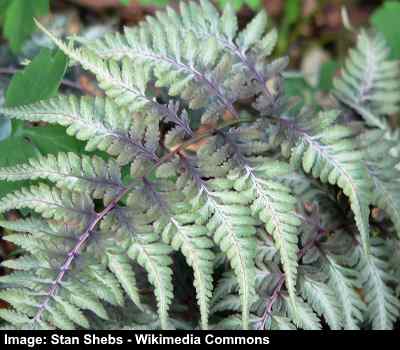
The Japanese Painted fern includes several cultivars. In the picture: Athyrium niponicum var.’pictum’
The Japanese Painted fern (Athyrium niponicum) is one of the prettiest ferns you can grow in your shady garden. This is a deciduous fern that has a creeping nature and is good for ground cover in the shade.
The pinnae (leaflets) are identified by their blue-green or silvery color that are attached to red or purple stems. There are a number of cultivars in this genus that have different types and colors of leaves.
Apart from their attractive color, Japanese Painted ferns are highly desirable due to their hardiness. They are a very cold hardy type of fern plant that can withstand temperatures as low as -30°F (-34°C). Like most outdoor ferns, the Japanese Painted fern needs plenty of shade.
Australian Tree Fern

There are a number of species of the Australian Tree fern. In the image: Alsophila australis (left) and Dicksonia antarctica (right)
Unlike the other ferns on this list, the Australian Tree fern is a type of tree and not a bushy garden plant. There are a number of species of these tree ferns such as the ‘Rough Tree fern (Alsophila australis), the ‘Lacy Tree fern’ (Sphaeropteris cooperi), or the ‘Soft Tree fern’ (Dicksonia antarctica).
Australian tree ferns can grow to between 15 and 50 ft. (4.5 – 15 m) tall. In some ways, these tree ferns resemble palm trees with a thick trunk that sprouts large fronds at the top. Some fronds can be up to 8 ft. (2.4 m) in length and fan out to make a canopy of up to 19 ft. (6 m) in diameter.
If you plant one of these tall tree ferns in your garden, ensure that it gets enough moisture. However, unlike other types of fern plants, these grow just as well in full sun as they do in the shade.
Asparagus Fern
One of the more unusual outdoor fern species is the Asparagus fern (Asparagus aethiopicus). This fuzzy-looking fern is perfect for rock or ornamental gardens or outdoor hanging baskets. Depending on the cultivar, Asparagus ferns can be scrambling or they can be tall growing.
Even though the tiny pinnae appear soft and furry, their small spines can cause skin irritation. The fern can be invasive in nature, so you should keep it under control with regular pruning.
One of the attractive features of this fern is small red berries that it sometimes produces. These contrast well with the light, lime-green foliage.
Although you can grow Asparagus ferns as an indoor plant, they are tricky to look after. However, depending on your climate, you may need to bring them indoors during the winter if they are in containers or hanging baskets.
Bird’s Nest Fern
The Bird’s Nest fern (Asplenium nidus) species from the Polypodiales order of ferns is a pretty fern for ornamental gardens. This species of fern grows on trees, rocks, and soil. This fern gets its name from the fact that the middle of the fern resembles a bird’s nest.
This variety of outdoor fern has wide leathery leaves (fronds) that may look like banana leaves. The long leaves can grow to between 20” and 60” (50 – 150 cm) and be up to 8” (20 cm) broad.
Due to its compact nature, the Bird’s Nest fern is a good ornamental fern for rock gardens. You just need to make sure that it grows in the shade and is kept moist.
One interesting feature of this fern is that its fronds will take on a crinkled appearance in the sun.
Cinnamon Fern
A common outdoor fern species is the Cinnamon fern (Osmundastrum cinnamomeum). This is a large variety of fern that has broad fronds with long pinnae. The fronds are wider at the base and taper to the end, giving them a triangular appearance.
Cinnamon ferns can grow between 1 and 5 ft. (30 – 150 cm) tall and can measure between 6” and 8” (15 – 20 cm) wide. To thrive outdoors, these ferns need plenty of water and grow well next to streams and ponds.
The name for this fern comes from the cinnamon-colored spores that develop on the fronds. These usually form in the middle of the plant, giving the fern a color that changes from green to light brown.
Related articles:

